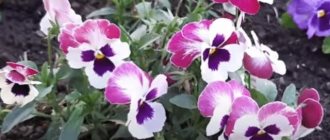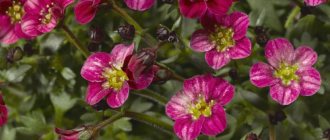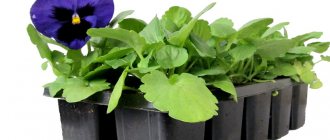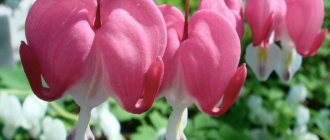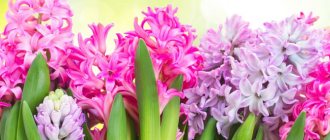Author: Elena N. https://floristics.info/ru/index.php?option=com_contact&view=contact&id=19 Category: Garden plants Published: February 27, 2019Last edits: November 03, 2020
- When to plant
- Growing conditions
- Wild tobacco (Nicotiana sylvestris)
The fragrant tobacco flower has long become a favorite of gardeners, thanks to its original aroma and the wide palette of shades in which its flowers can be painted. This plant attracts bees to the garden with its smell, and the variety of its varieties is simply amazing. The birthplace of fragrant tobacco is South America, and Christopher Columbus brought it to Europe. In nature, fragrant tobacco is a perennial, but in our climate it is grown as an annual crop.
Planting and caring for fragrant tobacco
- Flowering: from June to September.
- Planting: sowing seeds for seedlings - at the end of February or early March, planting seedlings in open ground - in the second half of May.
- Lighting: bright but diffused light or partial shade.
- Soil: fertile and moist.
- Watering: frequent and plentiful, in dry and hot weather - daily, but if the season is with normal rainfall, then you will have to water only from time to time.
- Fertilizers: when growing a plant in nutritious soil, fertilizers are not needed, and in poor soil, liquid complex mineral fertilizers with a low nitrogen content are applied twice a season: at the beginning of bud formation and at the beginning of flowering.
- Reproduction: seed.
- Pests: Colorado potato beetles and slugs.
- Diseases: the plant contains fungicides, so it is not affected by diseases.
Read more about growing fragrant tobacco below.
Reviews
The flower's variegation and unpretentiousness have made it a favorite among gardeners. The happy owners of this beauty share their admiration and talk about some of the difficulties in cultivating the annual.
Larisa Petrovna “I only met the plant in the fall and immediately fell in love with it. I was lured by the colorful picture on the package of seeds. There were no problems with sowing and seedlings. I planted seeds for seedlings in March, and transferred them to the flowerbed in May. In July, the bushes began to delight with multi-colored, fragrant buds resembling small stars.
For the sake of experiment, I cut it for a bouquet - they stood in the vase for quite a long time, filling the room with a pleasant aroma. There is only one drawback to fragrant tobacco - it is that the plant is grown as an annual. I want to dig up the bushes in the fall and transplant them into flowerpots. I hope that in the warmth of home, my flowers will delight me all winter.”
Svetlana – a novice gardener “I saw this handsome guy in a photo on the Internet. I immediately liked the interesting color of the buds - a light green shade. And the name was completely surprising - fragrant tobacco. I found the seeds in a flower shop and chose the brightest varieties. As a beginner in the flower business, I strictly followed the manufacturer's instructions. And voila! My flowerbed attracts all my neighbors with its diversity, and its intoxicating aroma allows me to relax at the end of a hard day at work.”
Nikolay “I’m not a fan of bouquets on the estate, but I regularly plant tobacco in the beds. The thing is that the plant attracts the Colorado potato beetle. This means that potato bushes are safe from this pest. And it’s easier to collect beetles from flowers.”
Ekaterina “And I had a negative result from my acquaintance with this flower. In the first year after sowing the seeds, only two or three bushes sprouted in open ground, and even those were weak and painful. The next year I sowed seeds for seedlings. But during the flowering process, it turned out that the buds did not emit any aroma. In general, I decided not to plant this flower again.”
Botanical description
Sweet tobacco is a herbaceous plant from the Solanaceae family, usually from 20 to 90 cm in height with erect stems, small star-shaped flowers and large leaves. The entire plant is covered with glandular hairs. Flowers, depending on the type and variety, can be yellow, white, crimson, red or pink, and plants with less brightly colored flowers have a stronger aroma. Typically, tobacco flowers open only after sunset. Flowering of fragrant tobacco begins in June and ends in September. In the evening, the fragrance of tobacco flowers intensifies. The plant has been in cultivation since 1867.
Growing fragrant tobacco from seeds
When to sow
Since annual fragrant tobacco is a heat-loving plant, it is better to grow it in seedlings. Sowing of fragrant tobacco seedlings is carried out at the end of February or beginning of March.
How to sow seeds
For sowing, you will need a shallow dish and a substrate consisting of equal parts of humus, peat and garden soil. The seed must first be placed in a damp cloth for several days to swell, but do not overexpose it - the seeds should not hatch.
- Spiraea Wangutta: planting and care, description of varieties
When sowing, small seeds of fragrant tobacco are laid out on the surface of the substrate without covering them, sprayed with water and covered with glass or film. Contain crops at a temperature of 20-22 ºC. Shoots may appear in 10-14 days, and then the film can be removed and the crops transferred to the brightest place.
Seedling care
Fragrant tobacco from seeds requires regular, but not very abundant watering and careful loosening of the soil. When the seedlings develop two true leaves, the seedlings are picked. How to pick fragrant tobacco? The seedlings are watered, carefully removed from the substrate along with the earthen lump and planted in separate cups. When the seedlings take root, the tops of the seedlings are pinched to stimulate tillering.
Planting fragrant tobacco in open ground
When to plant
Planting of fragrant tobacco in open ground is carried out when warm weather sets in, the ground warms up and return frosts pass - approximately from the second half of May. But two weeks before planting, the seedlings begin to get used to the open air, daily exposing the seedlings to the street for some time. At first, the session should last no more than an hour, but gradually the duration of the seedlings’ stay in the air should increase until it can stay there around the clock. And only after this the seedlings can be planted in the flower garden.
How to plant
Tobacco is grown in an area protected from strong winds and direct sunlight. Decorative types of tobacco are undemanding to the composition of the soil, but its fertility and humidity are important. Poor soil should be dug up with compost or humus in the fall and, if necessary, drainage material should be added to it.
When planting seedlings in open ground, you must adhere to the scheme developed by experts: the distance between holes should be at least 20-30 cm. Keep in mind that tall varieties of fragrant tobacco can reach almost a meter in height, and large plants need more space. First, the seedlings stretch out to their full height, and then begin to spread along the ground.
Before planting, add a little superphosphate to the holes, mix it with soil, and then transfer the seedling with a lump of earth into the hole, fill the hole with soil, compact the surface and water it.
- Crocuses: growing in the garden, types and varieties
When to plant seeds for seedlings
Tobacco species, including fragrant, can only be propagated by seeds. Flowers reproduce by self-seeding, so young tobacco can be found in any part of the site. If you want to avoid chaotic seed germination, then do not forget to remove flaccid parts of the plant, for example, buds or leaves, during care. For planting, you can use “mother” seeds or purchased from gardening.
If you want to preserve the bush for the coming year, then before frost, transplant it into a large pot and grow it at home. In the spring, the tobacco bush can again be transplanted into the ground on the site. In this way, you can turn annual bushes into perennial ones.
Since the plant loves warmth and moderate moisture, it is important to start planting in the soil prepared on the site with the onset of absolute spring heat, since frosts can kill the plant. For the south, planting can begin from the end of March until the beginning of May. In cold regions, planting approximately begins from May to June. To achieve germination, the seeds should be germinated first in late winter or early spring.
It is recommended to plant seedlings at a distance of 30 cm. Each bush must germinate in free space in order for the root system and branches to develop correctly.
Fragrant tobacco does not require personal care. It blooms with eye-catching flowers, and its leaves have sharp tips and are wide near the stems, giving the bush volume. Tobacco can germinate in different soil compositions – even ones that are not very favorable for other nightshade crops. Tobacco easily adapts to bright sun. However, it is better to plant it in the shade.
Caring for fragrant tobacco
Growing conditions
Growing fragrant tobacco requires the usual procedures for any gardener - watering, weeding, loosening the soil around the plant, fertilizing and protection from diseases and pests. It is also advisable to remove dried flowers so that the plant has a fresh and well-groomed appearance.
Water the fragrant tobacco frequently and generously - every day during the hot, dry season. However, if the summer has precipitation, you should not particularly worry about the plant.
As for fertilizing, when growing fragrant tobacco in nutritious soil, they will not be needed, and if the soil is poor, then feed the plant with complex mineral fertilizer twice during the growing season: the first time as soon as the buds begin to form, and the second at the beginning of flowering. Do not overuse nitrogen fertilizers, otherwise you will get a lush green mass of large leaves, and flowering will be sparse. Fertilizers are added to water for irrigation.
Diseases and pests
Fragrant tobacco is quite resistant to both diseases and pests. It contains many phytoncides that repel harmful insects. Their action protects not only the plant itself, but also nearby crops from pests.
Fragrant tobacco after flowering
In the fall, the most beautiful fragrant tobacco bushes are dug up, planted in pots and brought indoors, shortening the shoots by one third. Keep the plant in a bright place, water it as the soil dries. And with the onset of stable warmth, they are planted again in the flower garden.
Types and varieties
The following types of plants of the Solanaceae family are united under the general name “fragrant tobacco”:
Wild tobacco (Nicotiana sylvestris)
A plant reaching a height of 80 to 150 cm with straight stems and drooping, fragrant white flowers. This species is native to Brazil. The plant is ideal for mixed borders and growing in the background. Not long ago, a forest tobacco variety series was developed for container culture with a height of only 25 cm;
- Crocuses: planting in open ground in autumn
Langsdorff's tobacco (Nicotiana langsdorffii)
An annual plant up to 120 cm high with dark green bell-shaped flowers and an unusually pleasant aroma. Langsdorff tobacco grows wild in Chile and Brazil. A relatively low-growing variety of the Cream Splash species with a height of 60 to 90 cm was bred in cultivation;
Winged tobacco (Nicotiana alata = Nicotiana affinis)
A herbaceous perennial grown in cultivation as an annual plant. It has erect stems 60 to 70 cm high and small elongated or lanceolate leaves. The entire plant is covered with glandular hairs. Tubular, cream, white or carmine flowers, reaching a length of 7.5 cm, with a limb up to 5 cm in diameter, are collected in loose, large panicles. The flowers of the main species open only at night, but breeders have already developed varieties of winged tobacco that open their flowers during the day, as well as dwarf varieties that do not require garter.
In cultivation, winged tobacco is represented by forms and varieties of the large-flowered variety (Nicotiana alata var. grandiflora) with pink, mauve, white, purple, scarlet and dark red flowers. Some varieties reach a height of one and a half meters, and varieties of the Kana group do not exceed 40 cm. The most popular varieties of this species are:
- Evening Breeze is a plant about 60 cm high with crimson-red flowers;
- Red Devil is a compact variety up to 40 cm high with dark red flowers that do not close during the day;
- Crimson Rock is a plant with a height of 45 to 60 cm with red-crimson flowers. This variety received the Fleuroselect award;
- White Bedder is a plant about 50 cm high with white flowers open during the day;
- Lime Green - bushes up to 75 cm high with light green flowers;
- Domino Samen-Pink - small bushes up to 30 cm high with pinkish-salmon flowers.
The varieties Night Bonfire, Green Light, Havana Appleblossom, Lunevsky and others are also in demand in cultivation. In addition to individual varieties, you can find seeds of the following variety series on sale:
- fragrant tobacco Sensation - plants in this series reach a height of 60 to 90 cm;
- Niki series - plants up to 30 cm high, and the colors of flowers of different varieties - from white to crimson;
- Havana series – the height of plants of various colors is about 35 cm;
- Avalon - varieties of fragrant tobacco of various colors with a height of 15 to 30 cm;
- Perfume and Roulette are also low-growing varieties.
Sander Tobacco (Nicotiana x sanderae)
This is a garden hybrid of winged and wild Forget tobacco, obtained by breeders in 1903. The aromaless flowers of this plant are larger than those of winged tobacco. They are usually a reddish carmine hue, although there are also white-flowered varieties. Sander tobacco was the base plant for the development of many varieties of fragrant tobacco. The first generation of hybrids of this species, part of the Tuxedo series, are bushes up to 20 cm high. They look great both in containers and in flower beds. The most popular varieties of this series are:
- Tuxedo Lime - plants with lemon-yellow flowers;
- Tuxedo Saman Pink is the most popular variety with salmon pink flowers.
Characteristics of bushes
With up to 60 species, the fragrant tobacco plant is divided into 3 categories:
- Tall.
- Medium height.
- Dwarf.
Quite tall bushes - above 80 cm. It is preferable to present them on the far perimeter of the flower garden, near fences and bushes of other garden plants. This category includes Hypnosis, Sensation.
Medium-sized tobacco grows up to 30-80 cm. It decorates gazebos, terraces and loggias of apartments. Lilac Mist belongs to it.
Small plants grow only up to 30 cm. These varieties frame flower beds and decorate balconies. Dwarf varieties: Nicki Red, Havana Appleblossom, Rosa Gnom.
When planting fragrant tobacco, height classification is of primary importance.


